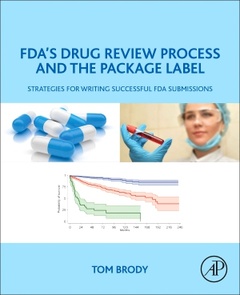FDA's Drug Review Process and the Package Label Strategies for Writing Successful FDA Submissions
Auteur : Brody Tom

FDA's Drug Review Process and the Package Label provides guidance to pharmaceutical companies for writing FDA-submissions, such as the NDA, BLA, Clinical Study Reports, and Investigator's Brochures. The book provides guidance to medical writers for drafting FDA-submissions in a way more likely to persuade FDA reviewers to grant approval of the drug. In detail, the book reproduces data on efficacy and safety from one hundred different FDA-submissions (NDAs, BLAs). The book reproduces comments and complaints from FDA reviewers regarding data that are fragmentary, ambiguous, or that detract from the drug's approvability, and the book reveals how sponsors overcame FDA's concerns and how sponsors succeeded in persuading FDA to grant approval of the drug. The book uses the most reliable and comprehensive source of information available for writing FDA-submissions, namely text and data from NDAs and BLAs, as published on FDA's website. The source material for writing this book included about 80,000 pages from FDA's Medical Reviews, FDA's Clinical Pharmacology Reviews, and FDA's Pharmacology Reviews, from one hundred different NDAs or BLAs for one hundred different drugs. Each chapter focuses on a different section of the package label, e.g., the Dosage and Administration section or the Drug Interactions section, and demonstrates how the sponsor's data supported that section of the package label.
Pharmaceutical and biotechnology industry scientists and companies, pharmacology and pharmaceutical science students and researchers who are interested in learning or need to participate in the FDA drug review process. Law firms and law schools with an interest in the regulatory role of the FDA.
- Reveals strategies for winning FDA approval and for drafting the package label
- Examples are from one hundred FDA-submissions (NDAs, BLAs) for one hundred different drugs, e.g., for oncology, metabolic diseases, autoimmune diseases, and neurological diseases
- This book uses the most reliable and comprehensive source of information available for writing FDA-submissions, namely, the data from NDAs and BLAs as published on FDA's website at the time FDA grants approval to the drug
Date de parution : 12-2017
Ouvrage de 670 p.
19x23.3 cm
Thèmes de FDA's Drug Review Process and the Package Label :
Mots-clés :
AUC; Absolute bioavailability; Accuracy of coding; Adjudicating AEs; Adjudicating efficacy; Adjudication; Adjusting for subject-years; Adverse events; Alcohol; Allocation ratio; Ambiguous data; Animal model; Antidepressants; Antidrug antibodies; Appropriated species; Area under the curve; Autoimmunity; BCS class; BLA; Baseline imbalance; Beta-blockers; Bioavailability; Black box warning; CTCAE; CTD; CYP enzyme; CYP isozyme; Case Report Form; Causal assessment; Causal relationship; Clinical Hold; Clinical hold; Cmax; Coadministered; Coadministration; Cockroft-Gault equation; Code of Federal Regulations; Comorbid conditions; Concomitant disease; Contraindications; Cytochrome P450; Cytokines; Dosage and administration; Dose delay; Dose discontinuation; Dose dumping; Dose interruption; Dose modification; Dose reduction; Dose titration; Double counting; Drug class; Drug class analysis; Drug interactions; Drug transporter; Drug-drug interactions; Embryofetal toxicity; Exposure; First-in-class; Food effect studies; Genetic marker; Glomerular filtration rate; Grapefruit juice; Hepatic impairment; High-fat meal; Hypersensitivity reactions; Imbalance in study drug arm and placebo arm of AE; Immunosuppressants; Impaired hepatic function; Impaired renal function; Indications and usage; Ketoconazole; Lumping; Lupus-like syndrome; Lymphoma; MAO inhibitors; Mechanism of action; MedDRA dictionary; MedDRA terms; Milk; Miscoding; NDA; NOAEL; Naranjo criteria; Neutralizing antibodies; Neutropenia; Off-label uses; Oligosaccharide; Opportunistic infections; P-glycoprotein; Package label; Patient heterogeneities; Pharmacokinetics; Placebo arm; Polyethylene glycol; Pooling; Postmarketing requirement; Pre-NDA meeting; Preferred Terms; Pregnancy


